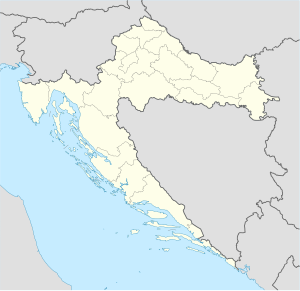물병자리 108
108 Aquarii| 관측 데이터 에폭 J2000 이쿼녹스 J2000 | |
|---|---|
| 별자리 | 물병자리 |
| 우측 상승 | 23h 51m 21.33832s[2] |
| 탈위임 | –18° 54′ 32.9937″[2] |
| 겉보기 크기(V) | 5.194[3] |
| 특성. | |
| 스펙트럼형 | A0VpSiSr[4] |
| U-B색지수 | –0.396[3] |
| B-V색지수 | –0.135[3] |
| 변수형 | α² CVn[5] |
| 아스트로메트리 | |
| 방사 속도(Rv) | +12.7km[6]/s |
| 적정운동(μ) | RA: +26.82[2]mas/yr Dec.: –4.27마스[2]/yr |
| 시차(시차) | 10.23 ± 0.31 마스[2] |
| 거리 | 319 ± 10 리 (98 ± 3 pc) |
| 절대치수(MV) | +0.08[7] |
| 세부 사항 | |
| 미사 | 3.21 ± 0.15[7] M☉ |
| 반지름 | 2.5 ± 0.3[7] R☉ |
| 루미도 | 132[7] L☉ |
| 표면 중력(log g) | 4.27 ± 0.10[7] cgs |
| 온도 | 12,274[7] K |
| 금속성 [Fe/H] | +0.90[8] 덱스 |
| 회전 | 3[9].75413일 |
| 회전 속도(v sin i) | 초속[10] 30km/s |
| 기타 지정 | |
| 데이터베이스 참조 | |
| 심바드 | 자료 |
물병자리 108(약칭 108Aqr)은 물병자리 적도 별자리에 있는 별이다.물병자리 108은 물병자리 바이엘(Bayer3)과 물병자리 ET 물병자리(Et Aquarii)도 포함하지만 플램스테드 명칭이다.그것은 겉으로[3] 보이는 5.194의 시각적 크기를 가지고 있고 적절히 어두운 하늘 아래 맨눈으로 볼 수 있다.연간 시차 변화량 10.23[2](오차 3%)을 기준으로 이 별까지의 거리는 319광년(98파섹)이다.
이것은 Ap 별이다. 즉, 그것은 특정한 요소들의 과잉을 보여주는 독특한 스펙트럼을 가지고 있다.태양 질량의 3배가 넘고 태양의 2.5배 반경이 된다.[7]108 물병자리 108호는 유효온도 12,274K로 외부 대기에서 태양의[7] 132배 광도를 방사하고 있다.[7]이 더위에 별은 A형 별의 흰색을 띤다.[11]
참조
- ^ Adelman, Saul J. (January 1999). "Variability of the uvby Light Curves of the Magnetic CP Star 108 Aquarii". Baltic Astronomy. 8: 369–383. doi:10.1515/astro-1999-0304. Retrieved 16 October 2021.
- ^ a b c d e f van Leeuwen, F. (November 2007), "Validation of the new Hipparcos reduction", Astronomy and Astrophysics, 474 (2): 653–664, arXiv:0708.1752, Bibcode:2007A&A...474..653V, doi:10.1051/0004-6361:20078357, S2CID 18759600.
- ^ a b c d Gutierrez-Moreno, Adelina; et al. (1966), "A System of photometric standards", Publications of the Department of Astronomy University of Chile, Publicaciones Universidad de Chile, Department de Astronomy, 1: 1–17, Bibcode:1966PDAUC...1....1G.
- ^ Abt, Helmut A.; Morrell, Nidia I. (1995), "The Relation between Rotational Velocities and Spectral Peculiarities among A-Type Stars", The Astrophysical Journal Supplement Series, 99: 135, Bibcode:1995ApJS...99..135A, doi:10.1086/192182
- ^ a b "* i03 Aqr". SIMBAD. Centre de données astronomiques de Strasbourg. Retrieved 2012-07-15.
- ^ Wilson, R. E. (1953), "General Catalogue of Stellar Radial Velocities", Carnegie Institute Washington D.C. Publication, Carnegie Institute of Washington, D.C., Bibcode:1953GCRV..C......0W.
- ^ a b c d e f g h i North, P. (June 1998), "Do SI stars undergo any rotational braking?", Astronomy and Astrophysics, 334: 181–187, arXiv:astro-ph/9802286, Bibcode:1998A&A...334..181N.
- ^ Vilhu, O.; Tuominen, I. V.; Boyarchuk, A. A. (1976), "Abundance Studies of Peculiar B Stars", in Weiss, W. W.; Jenkner, H.; Wood, H. J. (eds.), Physics of Ap Stars, Proceedings of IAU Colloq. 32, held in Vienna, Austria, 8-11 September, 1976, Universitatssternwarte Wien, p. 563, Bibcode:1976paps.coll..563V.
- ^ Barraza, L. F.; Gomes, R. L.; Messias, Y. S.; Leão, I. C.; Almeida, L. A.; Janot-Pacheco, E.; Brito, A. C.; Brito, F. A. C.; Santana, J. V.; Gonçalves, N. S.; Das Chagas, M. L.; Teixeira, M. A.; De Medeiros, J. R.; Canto Martins, B. L. (2022). "Rotation Signature of TESS B-type Stars. A Comprehensive Analysis". The Astrophysical Journal. 924 (2): 117. arXiv:2202.01022. Bibcode:2022ApJ...924..117B. doi:10.3847/1538-4357/ac3335. S2CID 246030494.
- ^ Abt, Helmut A.; Levato, Hugo; Grosso, Monica (July 2002), "Rotational Velocities of B Stars", The Astrophysical Journal, 573 (1): 359–365, Bibcode:2002ApJ...573..359A, doi:10.1086/340590.
- ^ Przybylski, A.; Kennedy, P. M. (1965), "Radial velocities and three-colour photometry of 166 southern stars", Monthly Notices of the Royal Astronomical Society, 131: 95–104, Bibcode:1965MNRAS.131...95P, doi:10.1093/mnras/131.1.95.



